Trainspotting (I)
A story of trains, computers, and two images.
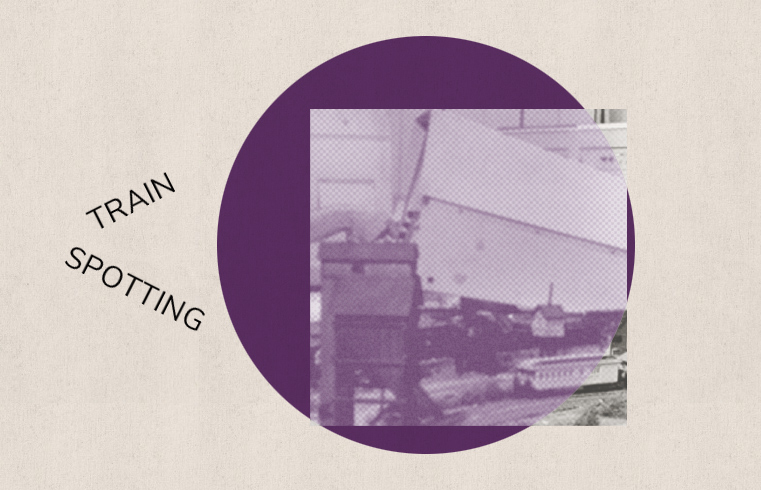
This is at the same time a continuation to what may become a loose series, namely, “Things on the Web that aren’t what they seem to be”, and the beginning of an entirely new one. Anyway, this is the story of two photos that are rather well known in the context of computer history. You may even have seen one or the other popping up on a website.
Since you are reading this blog, you may be even familiar with the broader context.
Context
In 1961, the MIT recieved a DEC
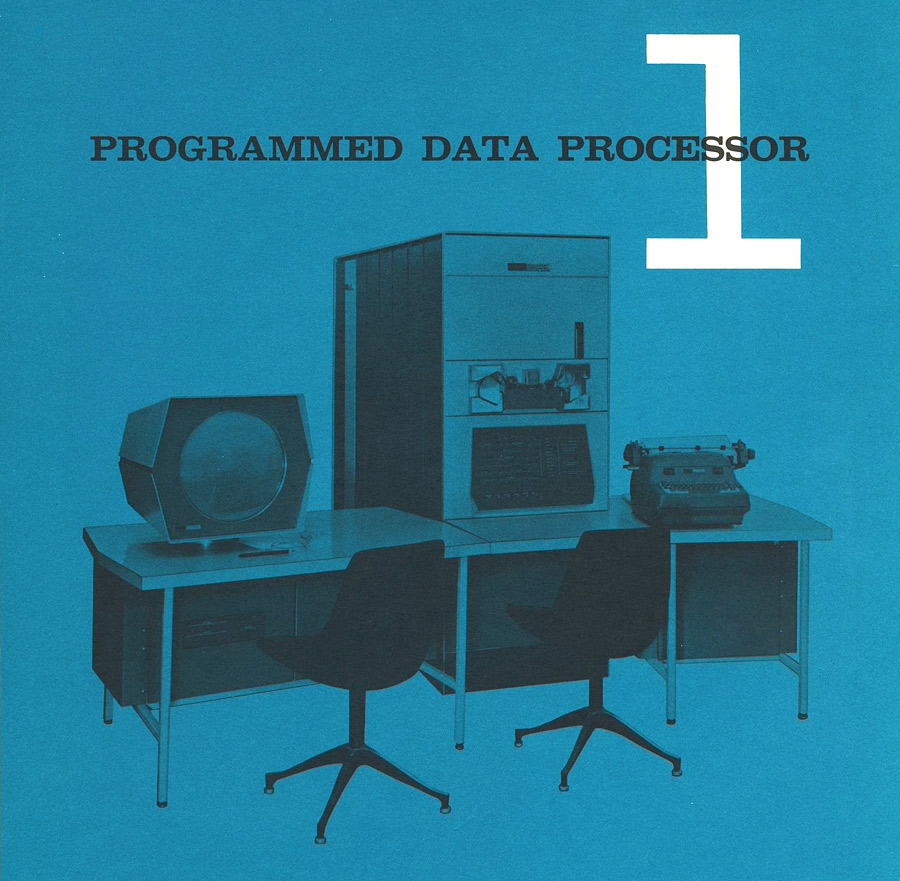
Image: Digital Equipment Corporation, brochure F-11B, 1962.
As it happened, there was a community of students gathering around the TX-0, which sprang into action to port essential tooling software from the TX-0 to the PDP-1, earning in turn rights to some runtime on the new machine. This very group also used to socialize at MIT’s Tech Model Railroad Club (TMRC), where it picked up reinforcement in form of a grad student by the name of Steve Russell, who, while not one of the TX-0 gang, had previously implemented the very first version of LISP on MIT’s IBM 704 mainframe. These teamed up to provide a demonstration program for MIT’s next annual Open House day in May 1962, a program, which, as they consented, ought to satisfy the following criteria:
- It should show off as many of the computer’s resources as possible, and tax those resources to the limit;
- Within a consistent framework, it should be interesting, which means every run should be different;
- It should involve the onlooker in a pleasurable and active way — in short, it should be a game.
Flavored with a bit of dedication to lowbrow science fiction and some contemporary Space Race enthusiasm this principal idea took shape as a game for two human players interacting in the virtual realms of the PDP-1’s scope, and Steve Russell eventually stepped out to put it to work. And so, what DEC got out of that deal, was Spacewar!, the very first digital video game.
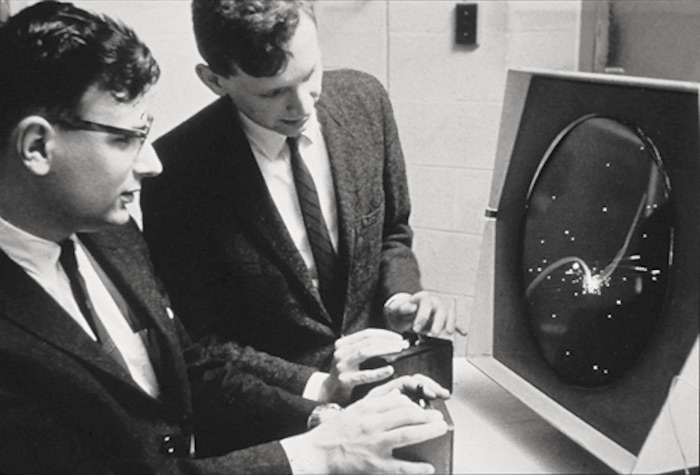
(Computer History Museum, Catalog No. 102631264; post-processed.)
(In case you are interested in the particulars, head over to “The Origin of Spacewar” by J. M. Graetz, 1981.)
The Photos
There are two photos to be found in the Computer History Museum’s (CHM) catalog, which are apparently documenting the process.
The first one is titled ”History - PDP-1 at the Tech Model Railroad Club”:
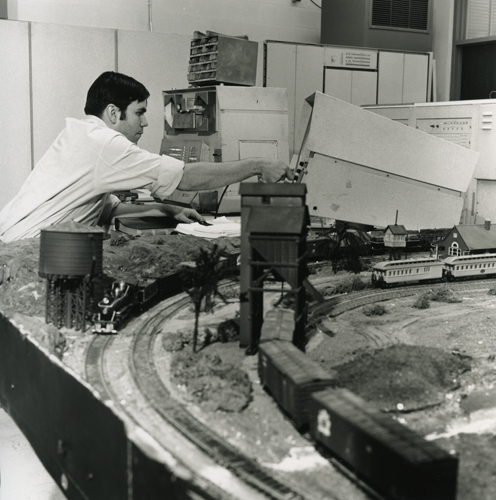
The second one is titled ”The Tech Model Railroad Club and PDP-1”:
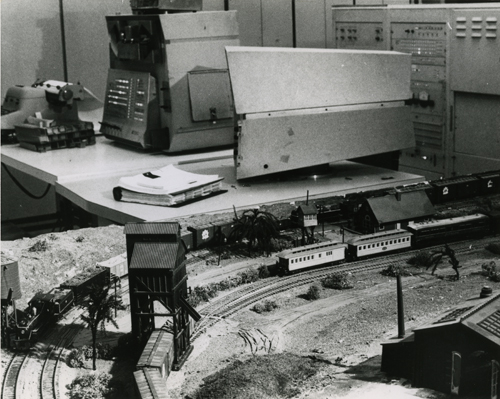
Both images share a date attribution of “1961 ca.” and show a computer in a deplorable state of disassembly placed at a model railway layout. The layout is the same in both images, even the trains and coaches are in the same positions, and general aspects and perspectives are similar, hinting at both photos being shot at the same occasion. Moreover, the coaches are of typical North American appearance, providing a clue for where the scene is set. Due to its form factor, the computer may be a DEC PDP-1 or DEC PDP-4 and surely, there’s also the iconic hexagonal housing of the Type 30 visual CRT display, which went with the PDP-1 and the PDP-4, to be discerned. A closer inspection of the console switches to be seen in the second photo confirms that this is, in deed, a PDP-1. The habitual appearance of the person, who appears to be operating a light pen on the first image, also seems to roughly fit the period (this may be 1960s, maybe a bit later, like around 1970). So, this is clearly the PDP-1 at the TMRC, maybe, while the TX-0 gang was porting the Macro assembler, maybe even during the development of Spacewar!. — How lucky we are to have these images, which are showing the PDP-1 in this noteworthy context!
But, are they?
Timeline
There are a few things we ought to know. Firstly, we know that the PDP-1 was delivered to the MIT at first without a display, which only arrived later, and that the porting of the TX-0 essential tools happened during this period (compare “The Origin of Spacewar”). Moreover, we know the exact date the PDP-1 was officially put into service, Monday, November 6, 1961, as provided by this invitation:

(Computer History Museum, Catalog No. 102664166.)
Click for a expanded view of the image.
According to the court proceedings of the so-called “Magnavox vs. Bally” case, October 28, 1975, the PDP-1 was delivered on Friday, September 15, 1961 (p.75) and was stored for a few weeks in a room in Marvin Minsky’s area accross the hall (p.57), in order to allow for some construction work (p.76) in Room 20-260, where it resided ever since.
Secondly, we know from the “Magnavox vs. Bally” court proceedings (see above) that the Type 30 Visual CRT display wasn’t available before the very end of this year, as it was installed on Friday, December 29, 1961 (p.88):
Q When was the Type 30 display delivered?
A The display was installed December 29, 1961.
The timeline simply doesn’t fit. The photos couldn’t have been shot in 1961, since the display Type 30 display hadn’t yet arrived, and they couldn’t have been taken after this, since the PDP-1 was installed in Room 20-260. The timeline simply doesn’t allow for the PDP-1 having been taken to the TMRC layout.
So what is going on here? Surely, there are people who ought to know!
The Layout
In particular, those who ought to know and are available, are Steve Russell and Peter Samson, who was somewhat of a spritus rector of the TMRC. Here is what Steve Russell had to say about these photos:
Peter Samson and I have frequently remarked to each other that the model railroad scene is NOT from The Tech Model Railroad Club at MIT.?? TMRC never had a PDP-1 or a layout that resembled the one in the pictures.?? Peter believes that is from the Amherst Club.
There seems to be a lot of confusion about these pictures.?? I think that they are all from the Digital Equipment archives, and were used by both the Boston Computer Museum and the Computer History Museum with the information from Digital Equipment.
I don't know of any pictures of the MIT PDP-1 as it was when Spacewar! was written and debugged.
I think that the attributions commonly associated with these photos are from the Digital archives, and are incorrect in several ways.(Steve Russell, PDP-1 Team mailing list, 2019/10/18.)
Peter Samson, on the other hand, denied to know the layout at all:
Actually I don’t know where the photo was taken (certainly not at MIT) and have no personal knowledge of a club at Amherst.
(Peter Samson, PDP-1 Team mailing list, 2019/10/25.)
So, it even isn’t the TMRC layout! (Having a look at the operator in the first photo, we could have allowed for a later date and different circumstances, like dating from the early 1970s, but this forbids us to grasp for this last straw.)
With neither the timeline nor the layout matching, we may rule out that these photos are showing the PDP-1 at the TMRC.
* How amazing ist that? *
To put this into perspective, there were just about 55 PDP-1s ever made. Half of the PDP-1s built between 1960 and 1965 were actually packaged as International Telephone and Telegraph (ITT) Automated Data Exchange (ADX) 7300 messaging system, used for switching 256 telegraph lines each, which hadn’t a display at all. (Major ADX 7300 cutomers included Eastern Airlines in Canada, the U.S. and Mexico, Trans World Airlines, the U.S. State Department, NASA, the U.S. Air Force and the Aluminum Company of Canada.) BTW, a not that unimportant footnote to computer history, Gordon Bell deleveloped the UART (Universal Asynchronous Receiver Transmitter) while working on this project.
(Hats off to Lyle Bickley for research on the ITT ADX 7300.)
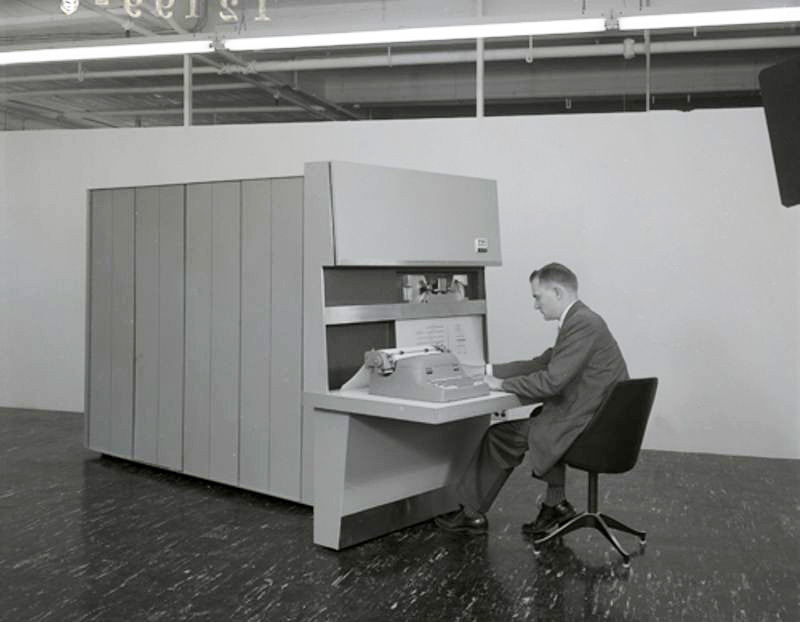
(Computer History Museum, Catalog No. 102649724; post-processed.)
Also, not every of the PDP-1s actually sold as PDP-1s featured a display. A prominent example is the PDP-1D timesharing prototype built to BBN’s specifications, which never had a display. According to some sources only aboult half of the PDP-1s featured a display of some kind, while we see here a PDP-1 not only with a display, but also with a light pen attached to it. This leaves less than a few dozens of installations eligble.
Further, while the PDP-1 was advertised as “reasonably priced”, it came at a considerable price tag. It certainly was reasonably priced, at an initial unit price of US$ 120,000 and an additional $ 14,300 for the Type 30 display, which put it more in the range of a better drum computer as compared to the $ 10,600 monthly lease for a contemporary IBM 1401 in its basic configuration. However, this is relative to the general cost of computers in the day. The $ 134,300 for a PDP-1 and a display was still 11 new family homes and a brand new average car in 1960-money’s worth. Hence, only major institutions or potent corporations entertaining a well-funded research lab at the very forefront of technecological innovation would afford one.
So, what are the chances, we would find another PDP-1 in the context of a model railroad club layout?
Provenance
So what are those photos showing in actuality? Time to get out our trusty detective cap and check, if it still fits. Have we added weight around the ears? Or, to the opposite, has our cranium shrunk over the lock-down?
First, we may have a closer look at the meta data, the CHM catalog associates with these photos. The first one reads the following:
(CHM, Catalog No. 102631219, excerpt.)
- Title
- History - PDP-1 at the Tech Model Railroad Club
- Catalog Number
- 102631219
- Lot Number
- X2675.2004
- Date
- ca. 1961
- Description
- This was collected along with other photos under DEC photo library identification number 10159, which consists of a group of historical photographs.
- Identifying Numbers
- File number 10159 DEC identification number
- Credit
- Gift of Hewlett-Packard Company
Ignoring the questionable attribution, there’s still some viable information left. Steve Russell was right, these attributions and titles apparently originated at the DEC company archives. The photo has even been published with a simliar caption in “Digital at Work: snapshots from the first thirty-five years” (ed. Jamie Parker Pearson, Digital Press, Burlington, MA, 1992; p.17):
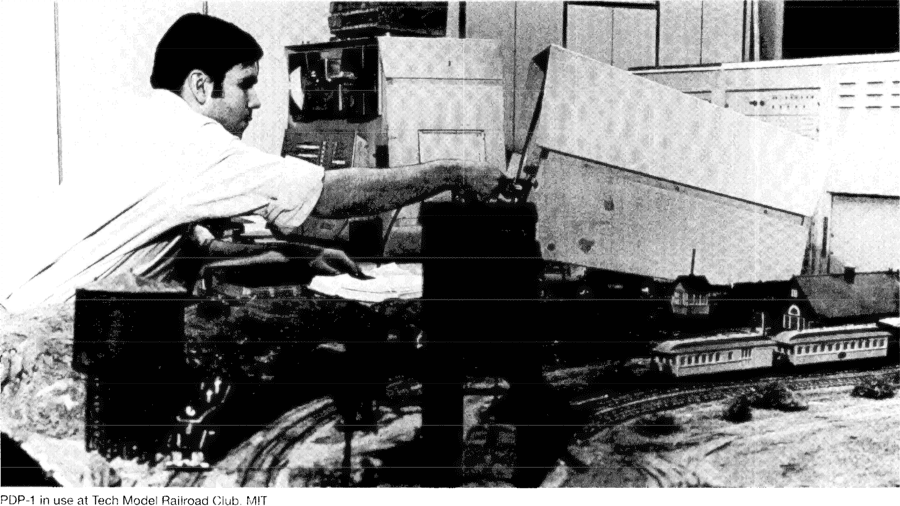
The meta data of the second image is even a bit more interesting:
(CHM, Catalog No. 102649722, excerpt.)
- Title
- The Tech Model Railroad Club and PDP-1
- Catalog Number
- 102649722
- Lot Number
- X3191.2005
- Date
- 1961 ca.
- Description
- Written on verso side in black pen ink is "V10 N4 p296", "PDD[sic]-1 at UM...". Written in pencil is "70 713", "5 7/8 x 4 1/4 ??" which is underlined, "5/38 x 4 1/4 = 57% for full image" and AFIPS FIG 11 Reviews". Written in black pen ink is "359". Written on the yellow form sheet in black pen ink is "Treat as Crop 32 1/4 x 25 1/2", "AFIPS-7", "5659", "57" next to the percentage box, and "11" written next to the Neg. No. and Fig. No. fields on the form.
- Credit
- Gift of J.A.N. Lee
This one, while obviously from the same photo shoot, comes from a different source (J.A.N. Lee) and provides an independent description. The description consists of two parts, some annotation written in black ink directly to the backside of the photograph, and some writing on a yellow label. Some of this is apparently related to publication purposes and reproduction sizes (“Treat as…” and “AFIPS FIG 11 Reviews”).
The real meat of the matter are the quotes which resemble the most an actual description, namely,
PDD[sic]-1 at UM...
and
70 713
The first one seems to provide the subject of the image, while the second one may provide the date. So it’s a PDP-1 at “UM”, and the date might be July 13, 1970. While we do not know, if this is a date at all, and whether this is the date, the photo was taken, or that it was used for publication (July may fit the preperations for the proceedings of the AFIPS ’70 Spring, held in May 1970, in case both sets of annotations were to refer to the same occasion), a date around 1970 matches well to the habitual appearance of the person on the first photo. A date closer to 1970, when the PDP-1 was approaching the end of its usable lifetime, than to the early 1960s would also suit the state we find this particular PDP-1 in these photos.
So what may “UM” stand for?
With a bit of imagination, provided that PDP-1s were primarily sold to instutions entertaining some kind of research lab, “U” may well stand for “university”. What universities are there, starting with “M”? Montana, Miami, Minnesota (we may rule this one out, since we know from Albert W. Kuhfelds article on his port of Spacewar that there wasn’t a PDP-1) … Michigan …
Michigan ?
Michigan does ring a bell. In the list of PDP-1 serial numbers we find the following entry:
| SN | TYPE | WHERE | DATE | SOURCE | PERIPHERALS |
|---|---|---|---|---|---|
| 33 | PDP-1C | Univ Of Michigan | ? | DEC Photo Archive, Ap Cards | 138, 139, 140, 340 |
This looks interesting, especially, since this refers explicitely to “DEC Photo Archive, Ap Cards” as a source. So we know that there were indeed photos of this particular machine in the DEC Photo Archive. It’s also one out of just 7 machines in total with mentions of the DEC Photo Archive in this list (and none of the others matching our initials “UM”.) Moreover, a PDP-1C matches the machine seen on these photos.
However, not everything is a perfect match: the listed peripherals do neither include a Type 30 display, nor a light pen (Type 32, 370, 375 or 377.) With reference to a list of DEC peripherals, the listed ones actually are:
138 … PDP-1/7/8 A-D Converter (6-11 bits)
139 … PDP-1/7/8 A-D Multiplexer Control (on Type 138, requires type 1578 mupliplexer switches)
140 … PDP-1/7 Output Relay Buffer (18 SPST w/ 18 bit buffer)
340 … PDP-1/4/7/6/9/10 Precision Incremental CRT Display
Especially, the Type 340 Precision Incremental CRT Display is bad news. This a completely other type of display, which looks like this:
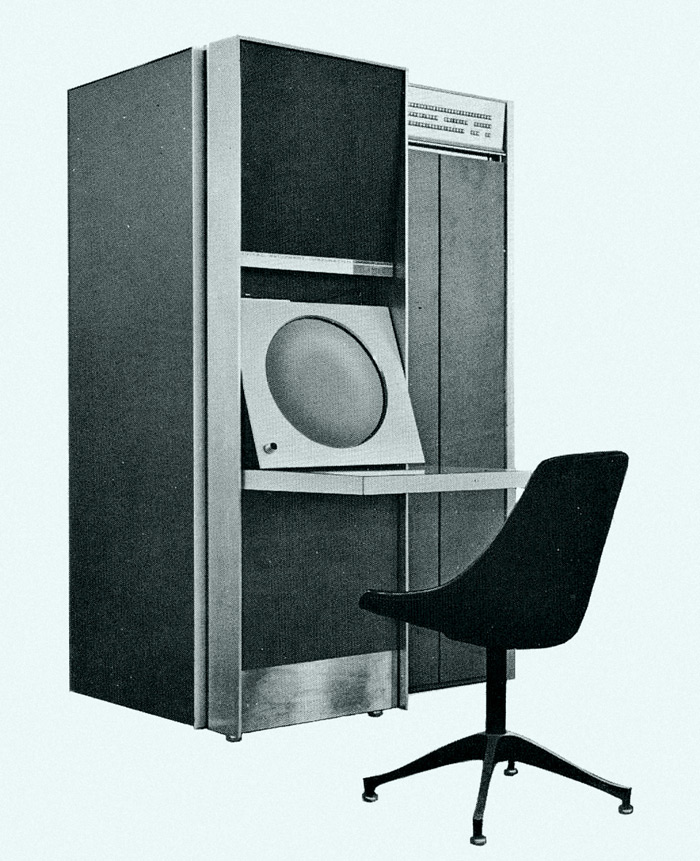
(Image source: DEC brochure F-13 (30), p. 5, 50-5/64)
But there’s still hope. The list of peripherals isn’t exhaustive (as can be seen from the required Type 1578 switches missing) and the Type 340 display was only availble as late as 1964/5 and came at quite a hefty price of US$ 28,600. Chances are, this was a later acquisition, which supplanted a Type 30 display previously obtained together with the machine.
I haven’t been able to find any references to a club layout at the University of Michigan at the time in question. Having a closer look at these photos, this me be even a bit larger scale than H0 gauge. There are some references to recent ties between the local LMRC club and the University of Michigan to be found on the Web, but this is by no means sufficient proof.
We can’t be sure and may still entertain a reasonable amount of doubt. However, this being the University of Michigan around 1970 is still the best guess. At least, it’s my best guess. I guess, it’s close.
In brief, this is what we are looking for:
- Photo series taken around 1970 (probably).
- DEC PDP-1 with Type 30 display and (probably) a light pen.
- Model railway club layout, probably 0 gauge (edit: well, rather H0, maybe something more exotic to the modern beholder, like S gauge), probably attached to the institution.
- An institution abbreviating to “UM”, where “U” is probably a North American university.
Note: Doubts have been raised regarding this being 0 gauge. I may want to have my eyballs recalibrated. ;-)
If you can confirm that these photos were indeed taken at the University of Michigan and/or can provide any background on these, or have other information on these photos, or even recognize the layout (there are some prominent features in the foreground), please contact me.
+++ Update +++
University of Massachusetts Amherst!
Thanks to Hacker News and especially user @mokedglass the origin of these photos seems to have been positively identified. It’s the University of Massachusetts. So Steve Russell’s suggestion regarding the Amhert layout (while erring on the side of following a suggestion by Peter Samson) was right, all along.
Compare the image caption in “A Historical Overview of Computer Architecture” by Richard E. Smith (IEEE Annals of the History of Computing, October-December 1988, pp. 277-303, vol. 10), Fig. 9:
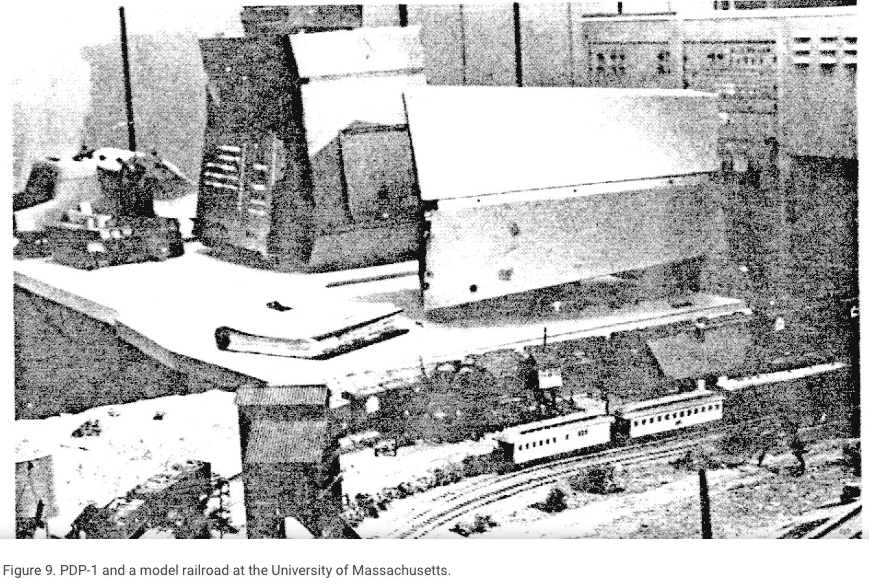
Caption: “Figure 9. PDP-1 and a model railroad at the University of Massachusetts.”
(Image: “A Historical Overview of Computer Architecture”, Fig. 9, Semantic Scholar / screenshot.)
The printed version has the year of publication as 1989 (Smith, Richard E., “A Historical Overview of Computer Architecture“, Annals of the History of Computing, vol. 10, no. 4, 1989, pp. 277-303), as opposed to the electronic citation, which states 1988 as the publication date, and figure 9 is found on page 296.
There, Richard E. Smith refers to a PDP-1 interfacing to the controls of a model railway, citing J.A.N. Lee, “Reviews: Hackers by Steven Levy” (Annals of the History of Computing, vol. 7, no. 3, July, pp. 270-272, 1985).
[Sadly, there doesn’t seem to be an electronic version of this review of “Hackers” by J.A.N. Lee.]
Update: Actually, there is, compare this update to the next post.

Note: In light of this new context, what we deemed to be the operation of a light pen may well be the operation of some auxiliary knobs and/or switches near or at the CRT display, as well.
Notably, this is the same J.A.N. Lee, who is referred to as the donor of our second image in the CHM catalog meta data! And we will soon learn more about J.A.N. Lee.
The history page on the University of Massachusetts Amherst CS program’s website confirms the existence of a PDP-1 at the site:
The PDP-lB of those early days was soon replaced by three PDP-11s and a PDP-l5 with a graphics system. (www.cics.umass.edu/about/history-school-computer-science)
This article also points out that J.A.N. Lee was appointed Program Head of the new CS program at UMass Amherst in September of 1964.
(…) J.A.N. Lee was appointed Program Head in September of 1964. (www.cics.umass.edu, ibidem)
According to HN user @peapicker, J.A.N. Lee is also the person operating the PDP-1 in our first photo!
The notion of a “PDP-lB” is somewhat curious, since we only know of 2 PDP-1B production prototypes, one going to BBN, the other one going to LLNL. (However, at times, I did have the feeling of there possibly being photos depicting a third one. But it may be also an error in this document. Notably, there isn’t any notion of a PDP-1 in Amherst in the serial numbers list.)
Curiously, the “PDP-1B” at Amherst seems to be confirmed by this CHM catalog entry, which may be for a similar image, which is not available online in digitized form:
(CHM, Catalog No. 102757910, excerpt.)
- Title
- PDP-1/B and miniature model railroad at University of Massachusetts
- Catalog Number
- 102757910
- Lot Number
- X2675.2004
- Type
- Still image
- Format
- Negative
- Identifying Numbers
- File number 4185 DEC identification number
- Credit
- Gift of Hewlett-Packard Company
Notably, this is the same lot number as provided for our first photo!
Hats off to HN user Evan Anderson for finding this one!
By this, this humble blog post has become a legit Hacker News success story! :-)
See also this follow-up post regarding the Amherst PDP-1: PDP-1 Spotting — The Amherst Mystery.
Hacker News discussion: news.ycombinator.com/item?id=26292781
Norbert Landsteiner,
Vienna, 2021-02-28